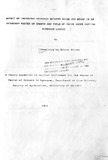Effect of increased intimacy between maize and beans in an intercrop system on growth and yield of maize under varying nitrogen levels.
Abstract
Field
Nairobi's
experiments
Faculty of
increasing
were conducted at the University
Agriculture farm to investigate
of
the
merits
plants
of the proximity between maize and bean
in an intercrop system and how N-fertilizer levels
influence this interspecific interaction. Four planting
patterns and four nitrogen levels were tested in a factorial
experiment and laid out in a completely randomised block
design with three replicates. The planting patterns consisled
of sole maize, maize and beans intercropped in alternate rows,
maize and beans intercropped as alternating plants in the same
row and maize and beans intercropped in the same hi I I. The N
levels were 0, 50, 100 and 150 Kg N/ha. Maize variety Embu 512
and bean variety GLP-2 were used. Plants were sampled biweekly
during the growing season to determine dry matter
weight and leaf area. At the end of the vegetative cycle,
yield and yield components were also measured.
Results
and at 19
showed that at 15 and 19 WAE in the first season
WAE in the second season, maize intercropped with
beans in alternate rows had statistically inferior dry matter
compared to maize sown in the rest of the patterns, whose dry
matter
plants
yields were statistically similar. Dry matter of maize
significantly increased with N application at
sampling times. Dry matter of bean plants
patterns,
was
all
not
significantly affected by the planting but N
application significantly increased this parameter. Planting
patterns had no significant effect on Leaf area indices of
both maize and bean plants, but this parameter was
significantly increased with N application in maize plants.
Planting patterns and nitrogen application had a
significant effect on maize grain yield in bolh spasons. The
interaction
between the planting patterns and N levels was
significant in the first season. At 0 and 50 Kg N/ha, maize
intercropped with beans in the same hole significantly outyielded
maize sown in the rest of the patterns; whereas sole
maize and maize intercropped with beans in the same row, whose
yields were statistically similar, gave significantly higher
grain yield than maize intercropped with beans in alternate
rows. At 100 and 150 Kg N/ha, sole maize had grain yield that
was non-significantly higher than those of maize intercropped
with beans in the same row or same hole, but statistically
higher than that of maize intercropped with beans in alternate
rows. In the second season, a tal I N Ieve 1s, there were no
significant differences among the planting patterns except at
o and 50 Kg N/ha where maize intercropped with beans in the
same hole significantly out-performed maize intercropped with
beans in alternate rows. Maize intercropped with beans in the
same hole did not significantly respond to application of more
than 50 Kg N/ha whereas maize sown in the rest of the patterns
did not significantly respond to application of above 100 Kg
N/ha. Both planting patterns and N levels had a significant
effect on the number of kernels per cob-row, lOO-kernel weight
and cob-length, but had no effect on the number of rows per
cob. Planting patterns had no significant effect on bean
yields, but N application significantly increased this
parameter.
Based on these results, it was concluded that increased
intimacy between maize and bean plants in an intercrop system
increased maize yields only under low N levels.
Citation
Chemining'wa, G.N(1992). Effect of increased intimacy between maize and beans in an intercrop system on growth and yield of maize under varying nitrogen levels.Sponsorhip
University of NairobiPublisher
Department of Plant Science and Crop Protection, University of Nairobi
Description
Msc Thesis

